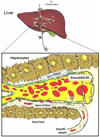Gastrointestinal lymphatics in health and disease
- PMID: 20022228
- PMCID: PMC3026597
- DOI: 10.1016/j.pathophys.2009.09.003
Gastrointestinal lymphatics in health and disease
Abstract
Lymphatics perform essential transport and immune regulatory functions to maintain homeostasis in the gastrointestinal (GI) system. Although blood and lymphatic vessels function as parallel and integrated systems, our understanding of lymphatic structure, regulation and functioning lags far behind that of the blood vascular system. This chapter reviews lymphatic flow, differences in lymphangiogenic and hemangiogenic factors, lymphatic fate determinants and structural features, and examines how altered molecular signaling influences lymphatic function in organs of the GI system. Innate errors in lymphatic development frequently disturb GI functioning and physiology. Expansion of lymphatics, a prominent feature of GI inflammation, may also play an important role in tissue restitution following injury. Destruction or dysregulation of lymphatics, following injury, surgery or chronic inflammation also exacerbates GI disease activity. Understanding the physiological roles played by GI lymphatics is essential to elucidating their underlying contributions to forms of congenital and acquired forms of GI pathology, and will provide novel approaches for therapy.
Copyright © 2009 Elsevier Ireland Ltd. All rights reserved.
Figures



References
-
- Potter P. On Glands. Vol VIII. Cambridge: Harvard University Press; 1995. Hippocrates; pp. 108–125.
-
- Crivellato E, Travan L, Ribatti D. The Hippocratic treatise 'On glands': the first document on lymphoid tissue and lymph nodes. Leukemia. 2007;21:591–592. - PubMed
-
- Chikly B. Who discovered the lymphatic system. Lymphology. 1997;30:186–193. - PubMed
-
- Granger DN. Intestinal microcirculation and transmucosal fluid transport. Am J Physiol. 1981;240:G343–G349. - PubMed
-
- Granger DN, Barrowman JA. Microcirculation of the alimentary tract I. Physiology of transcapillary fluid and solute exchange. Gastroenterology. 1983;84:846–868. - PubMed
Grants and funding
LinkOut - more resources
Full Text Sources
Other Literature Sources

